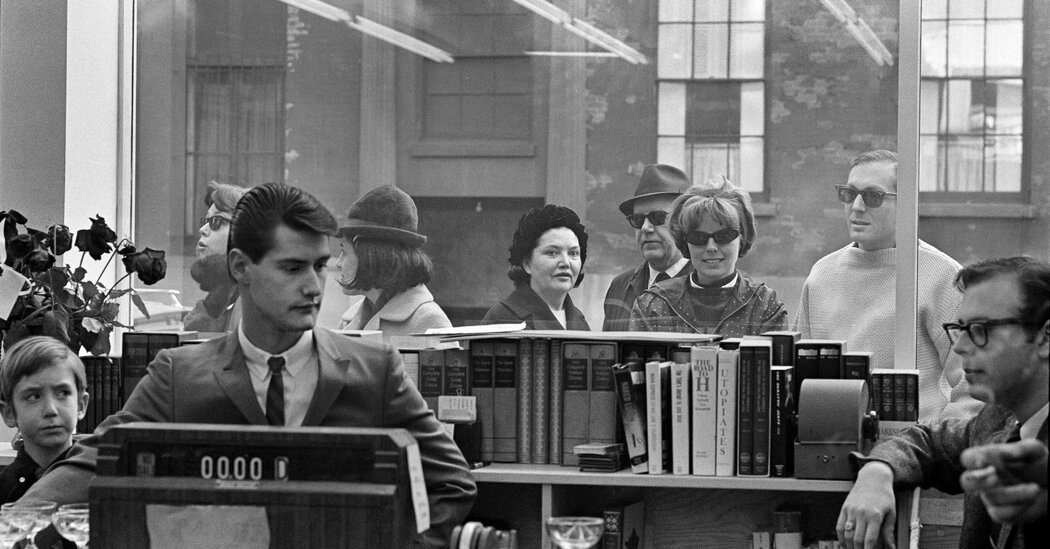
New York City is home to wonderful bookstores, but there used to be so many more of them to choose from — from Coliseum Books, just south of Columbus Circle; to Ivy’s Curiosities and Murder Ink on the Upper West Side; to the dearly departed St. Mark’s Bookshop in the East Village. By one count, there were 386 booksellers in Manhattan in 1950, including almost 40 on a six-block stretch of Fourth Avenue. (By comparison, there are fewer than 100 in the city now.) Here’s a look back at a few old favorites.
Dozens of bookstores once lined Fourth Avenue — so many that, in 1969, a Times article about the area noted, “What Lincoln Center is to music, what Broadway is to theater,” Fourth Avenue “is to rare, used and antiquarian books.” Jack Biblo, a co-owner of Biblo & Tannen’s — shown here in about 1940 — reminisced about the street in 1981, telling The Times: “We were all a little peculiar. When I started, you had an old Russian revolutionary down the street who kept a wood-burning stove in the middle of his store. If he liked you, he gave you a cup of tea. If he didn’t like you, he threw you out. If he told you a price and you said you’d think about it, he’d double the price.”
Lewis H. Michaux left preaching to open his Harlem bookstore, the African National Memorial Bookstore, in 1930, and it remained a fixture in the community — and a center of Black politics and intellectual activity — until it closed 44 years later in 1974. “It’s my baby, but it’s got too heavy for me,” he told The Times.
The Green Book Shop, seen here in 1969, was one of Fourth Avenue’s mainstays.
In a 1962 Times article, the writer Gay Talese talked to Richard Kasak and Seymour Rubin, the owners of Bookmasters, a Times Square paperback shop that stayed open all night for “literate insomniacs.” Talese wrote, “Before Messrs. Kasak and Rubin decided to open Bookmasters, shoulder to shoulder with Broadway’s grind houses, they were warned by friends that a bookshop in the area could survive only by peddling pornography, girlie magazines and detective thrillers.” Kasak told Talese: “Well, we’ve proved that this isn’t so. We do not have one pornographic book in this shop. You know, 42nd Street isn’t as bad as people say. It isn’t as bad as Greenwich Village. There you have those maniacs from the Bronx looking for a good time; those college kids lose control. I feel much safer on 42nd than in the Village.”
John Moore (left) and Kanya Ke’Kumbha at the Tree of Life Bookstore on 125th Street in Harlem in 1976. Carrying books on metaphysics, astrology, herbology and the occult, the shop was also called U.C.L.A., for University at the Corner of Lenox Avenue. “This is our purpose,” Ke’Kumbha told The Times in 1976, “to raise the consciousness levels of our community.”
The Manhattan branch of A Different Light, an iconic gay bookstore chain, closed in 2001. In 1993, the company’s president and co-owner, Norman Laurila, told The Times that while some gay literature might find its way to mainstream retailers, his stores’ roles “as cheerleader, social center and political pulse taker for the book-reading gay community” could not be replicated.
The Doubleday Book Shop, seen here in 1972, was at Fifth Avenue and 56th Street. In a 2006 Times article, Dan Kois wrote, “A special attraction of Doubleday was that it stayed open until 11 p.m., reminding the writer Fran Lebowitz of a time when ‘Midtown was for New Yorkers, not just tourists; you could go there late at night and pick up anything.’”
The Gotham Book Mart, one of the city’s most famous literary fishing holes, had several locations in the West 40s. In 1972, when the store’s founder, Frances Steloff, turned 85, she showed a Times reporter around and, motioning toward a shelf, said, “This is why I’m still here instead of sunning myself in Florida — to get more of these books in the hands of young people.”
George Rubin, seen here in the window of his Fourth Avenue bookstore, told The Times in 1969 that he remained optimistic about the book-selling business. Books are part of education, he said, and “education will never stop.”
Tina Jordan is the deputy editor of the Book Review. Erica Ackerberg is a photo editor at The Times.



